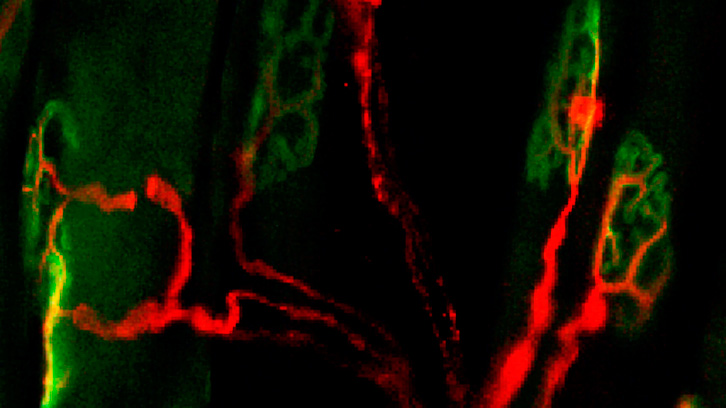Gene therapy for amyotrophic lateral sclerosis

Amyotrophic lateral sclerosis (ALS) is a neurodegenerative disease characterized by the selective loss of motor neurons, the neurons responsible for controlling the skeletal muscles. Because of this degeneration patients experience loss of strength and progressive muscle weakness that culminates with a fatal outcome between 2 and 5 years after diagnosis.
As in several other neurodegenerative diseases, the death of motor neurons in ALS is a complex multifactorial process, in which several cellular processes present alterations. Among these, the degeneration of the neuromuscular junction, the connection between the axon of the neuron to the skeletal muscle, is one of the hallmarks. To fix this disconnection, the body has an endogenous mechanism of compensation, known as collateral branching, where the axon of a neuron branches and reinnervates denervated muscle fibers that regain their function.
Some neurotrophic factors, such as Neuregulin type 1 (NRG1), regulate this compensatory process. NRG1 contributes to axonal regeneration and maintenance of the neuromuscular junction. However, several studies have shown that this compensatory mechanism is altered in patients with ALS. To restore this endogenous potential for recovery, in this work we have increased the levels of Nrg1 in skeletal muscle by using gene therapy vectors.

Experimental design of the study, in which a viral vector to induce over-expression of Nrg1 was injected into the muscle.
Our results show that the increase of NRG1 expression in a mouse model of ALS, the SOD1 transgenic mouse, promotes collateral branching of motor axons acting through cells located at the neuromuscular junction, known as terminal Schwann cells. These cells have a receptor for NRG1, the ErbB4 receptor. The ErbB4 receptor, when activated by NRG1, promotes migration of Schwann cells to denervated neuromuscular junctions, thus promoting collateral reinnervation. In addition, we found that this process was completely blocked by administering a drug that inhibits ErbB receptors, thus demonstrating the selectivity of the process.
In summary, this study shows that over-expression of NRG1 in skeletal muscle plays a crucial role in promoting collateral reinnervation in ALS. In addition, the study of this process opens up new venues of research to develop therapies that promote reinnervation of denervated muscles, thus achieving functional recovery.
Neurosciences Institute
Universitat Autònoma de Barcelona
CIBERNED
References
Mancuso, R et al. Neuregulin-1 promotes functional improvement by enhancing collateral sprouting in SOD1(G93A) ALS mice and after partial muscle denervation. Neurobiol Dis.2016 Nov; 95:168-178. doi: 10.1016/j.nbd.2016.07.023.


